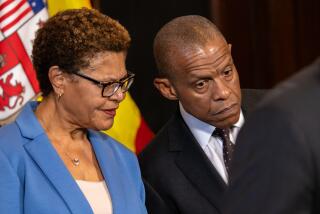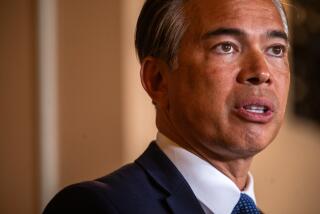Some warn that Gov. Jay Nixon’s curfew for Ferguson, Mo., may backfire

Molly Hennessy-Fiske describes the new policing approach during protests and public reaction to the release of the name of the Ferguson police officer who fatally shot Michael Brown.
- Share via
Reporting from Ferguson, Mo. — In an unusual declaration for an American city, Gov. Jay Nixon imposed a midnight-to-5 a.m. curfew Saturday after fresh violence erupted here amid public anger over the shooting death of an unarmed black man by a white police officer.
The governor’s curfew and state-of-emergency decree underscored the gravity of the situation in Ferguson, where officials have been unable to calm tempers and racial tensions since the Aug. 9 shooting of 18-year-old Michael Brown by police Officer Darren Wilson.
Critics, from black leaders in Ferguson to Amnesty International USA, were quick to assail Nixon’s move and said it could further infuriate protesters who have gathered on the streets of the St. Louis suburb nightly since Brown’s death.
Some protests have led to looting by groups of young men. Many protesters have tried to prevent the looting, only to see shop windows smashed and youths fleeing with stolen goods.
At a chaotic news conference where Nixon was shouted down at times by residents demanding that charges be filed against Wilson, the Democratic governor said the only way to restore peace was to ensure safety on the streets.
“We cannot have looting and crimes at night,” Nixon said. “We can’t have people fearful.”
“We can’t have police officers killing people!” someone in the crowd yelled.
State Highway Patrol Capt. Ron Johnson, whom Nixon put in charge of Ferguson’s security on Thursday, said enforcement of the curfew would not be heavy-handed, but his words did not quiet skeptics. Nixon did not say how long the curfew would be in place.
“It’s clear that the community doesn’t feel heard,” Steven W. Hawkins, executive director of Amnesty International USA, said in a statement. “We criticize dictators for quelling dissent and silencing protesters with tactics like curfews; we’ll certainly speak out when it’s happening in our own backyard.”
Malik Shabazz, the national president of Black Lawyers for Justice and a former leader of the New Black Panther Party, said police could complicate matters if they tried to enforce the midnight deadline.
“They go out there, it’s over,” Shabazz said. He said he had 100 volunteers better suited to keep watch on demonstrators. “We gotta secure it ourselves.”
As twilight descended on Ferguson, police blocked vehicular traffic on the south end of West Florissant Avenue, the scene of most protests and unrest. They also barricaded a shopping complex about half a mile down the road. At least 200 demonstrators holding signs and chanting cries for justice marched along the avenue in a peaceful procession.
Last year, Massachusetts Gov. Deval Patrick, also a Democrat, asked residents of Boston, Cambridge and Watertown to shutter themselves inside as police scoured the area for the brothers suspected of bombing the Boston Marathon. New Orleans imposed a curfew in the chaos after Hurricane Katrina in 2005, and in 2001, Cincinnati declared a curfew after a white police officer’s shooting of an unarmed black teen led to riots.
Ferguson officials had hoped that Johnson’s presence would calm the city. Johnson, who is black and grew up in Ferguson, took over security from the city’s white police chief, Thomas Jackson, on Thursday, after five consecutive nights of clashes between protesters and police. Johnson immediately called off the military vehicles and tear gas that had been used on demonstrators, and Ferguson enjoyed its first calm night Thursday.
That changed when police on Friday released a report naming Brown as a suspect in a strong-arm robbery that had occurred minutes before he was shot. Brown’s family and many Ferguson residents said the robbery report, which was accompanied by a video of the incident that was also released, was aimed at deflecting attention from what they see as the real crime: Wilson’s shooting of an unarmed young man.
Freeman Bosley Jr., a lawyer representing the man who was walking with Brown when he was shot, said releasing the report and video was like “throwing a hand grenade at the table.”
A federal law enforcement source said Saturday that Ferguson police had planned to release the video Thursday, but were talked out of it by federal officials.
“We strongly objected and we told them it would just embroil the community,” said the source, who was not authorized to speak on the investigation and asked not to be named. When the video was made public, the source said, “we told them we were not happy.” The source added that FBI agents working a separate civil rights investigation into the shooting had acquired the video and didn’t plan to make it public.
Bosley’s client, Dorian Johnson, and several other witnesses have said Wilson shot Brown as he held up his hands. Police have said Brown attacked Wilson and was shot during a scuffle.
FBI agents have begun interviewing people in Ferguson as part of a federal investigation into the shooting. St. Louis County prosecutors also are investigating Brown’s death, but there have been calls for the county prosecutor, Robert McCulloch, to withdraw from the inquiry because of what some critics say is a poor history of prosecuting law enforcement officers in controversial cases.
“There is a history of reduced charges or no convictions at all,” said U.S. Rep. William Lacy Clay, a St. Louis Democrat. Clay said the “only way to true justice” was to have an independent investigator because of the “past history of prosecutions of police shootings in St. Louis County.”
Ed Magee, a spokesman for McCulloch, said the prosecutor hoped to present evidence to a grand jury as soon as this week. Magee denied allegations of bias by McCulloch.
“That’s just not true. He can be objective,” he said, noting that McCulloch had held the elected office since 1991. “Always has been.”
McCulloch was county prosecutor in 2000, when two white enforcement officers shot to death two unarmed black men in a car in Berkeley, about two miles from Ferguson. Then, as now, officials delayed identifying the law enforcement officers amid public anger.
A grand jury declined to indict the officers, who said they had been in danger of being run over as they tried to arrest one of the men in the car on drug charges. A federal civil rights investigation concluded the officers fired “out of fear and panic.” The St. Louis Post-Dispatch reported that on grand jury tapes, only three of 13 detectives who testified said the car was moving toward the officers when they opened fire. Two of those three were the shooters.
At the news conference, Nixon and Johnson urged residents to cooperate with the curfew. “This is not to silence the people of Ferguson,” Nixon said.
But Mary Moore, a protester who lives in nearby Florissant, was worried. Rather than enforcing a curfew, she said, officials should focus on investigating Brown’s death.
“Until that happens,” Moore said, “the curfew is a problem before it starts.”
tina.susman@latimes.com
matt.pearce@latimes.com
molly.hennessy-fiske@latimes.com
Susman reported from New York, Pearce and Hennessy-Fiske from Ferguson, Mo. Times staff writers Richard A. Serrano in Washington and Maya Srikrisnan in Los Angeles contributed to this report.
More to Read
Sign up for Essential California
The most important California stories and recommendations in your inbox every morning.
You may occasionally receive promotional content from the Los Angeles Times.
















